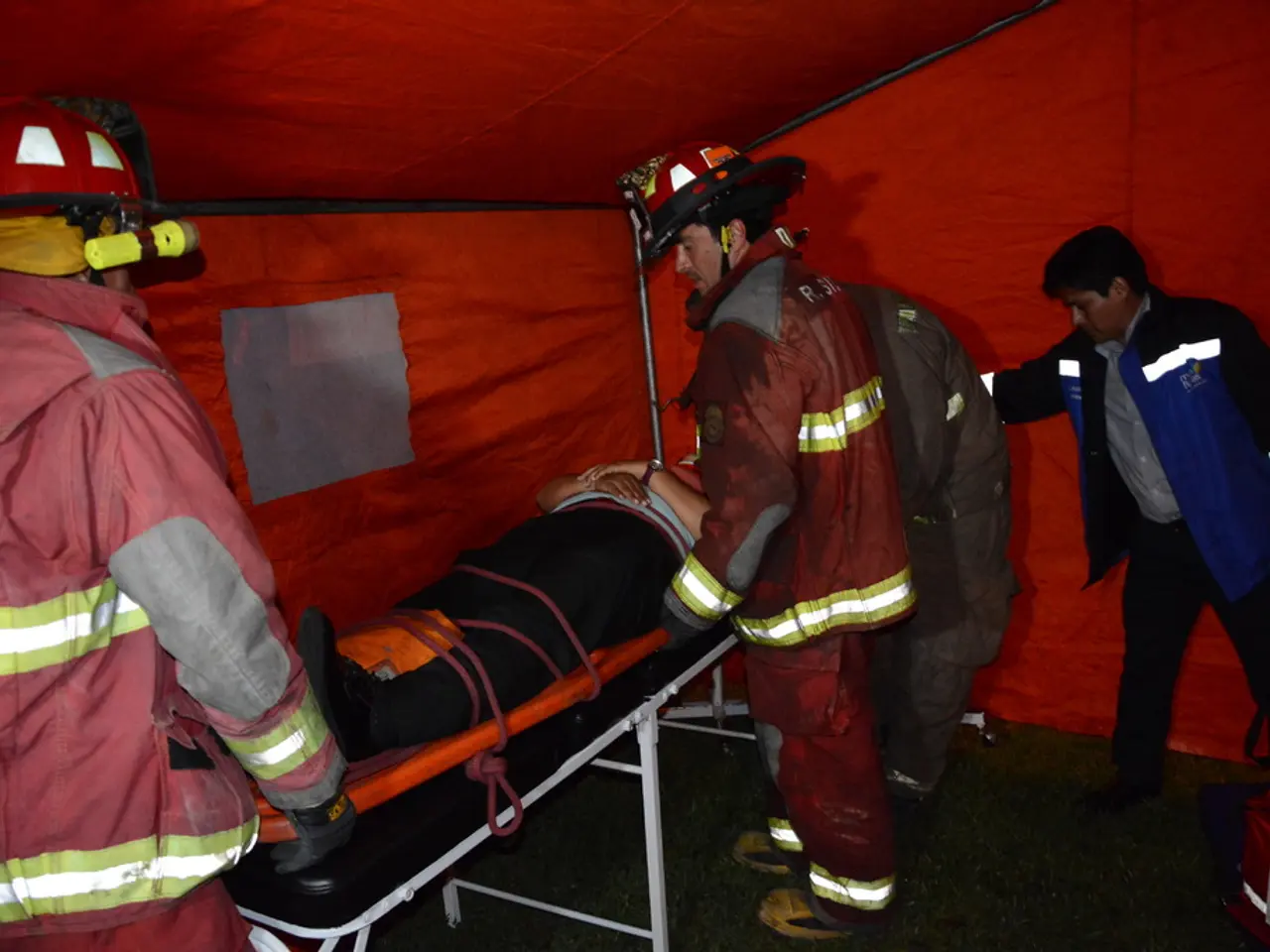Boston Scientific embraces NICE recommendations for application of pulsed field ablation
The National Institute for Health and Care Excellence (NICE) has issued positive guidance for the use of pulsed field ablation (PFA) in treating atrial fibrillation (AF) within the NHS in England and Wales. This recommendation, published in July 2025, marks a significant step forward in the adoption of non-thermal ablation technologies for cardiac arrhythmias in the UK [1][4][5].
The guidance supports the use of Boston Scientific's FARAPULSE PFA System, which became the first commercially available cardiac PFA technology in Europe after receiving CE mark in 2021 [2].
Key points from NICE's guidance include:
- PFA is recommended as an option for treating NHS patients with AF, using devices such as the FARAPULSE System [1][2][3]. - Clinical and economic data show that PFA is effective in reducing AF and its symptoms, improves quality of life in the short term, and does not raise major safety concerns [1][2]. - Compared to standard cryoablation, PFA is associated with a 3% reduction in total treatment costs per patient over 12 months, lower complication rates, and shorter procedure times [1]. - The guidance highlights the minimally invasive nature of PFA, positioning it as a valuable addition to current treatment pathways for AF [1]. - The guidance is based on current evidence and will be reviewed if new evidence or safety concerns emerge [3]. It is also endorsed by Healthcare Improvement Scotland as required by UK legislation [3].
NHS commissioners and providers are expected to ensure appropriate governance for introducing new devices and procedures, in line with local duties and environmental sustainability [3]. Healthcare professionals are expected to consider this guidance when making treatment decisions, in consultation with patients and carers [3].
The recommendation supports Boston Scientific's FARAPULSE System amid increasing competition from other major manufacturers entering the PFA market [1]. The guidance is expected to influence clinical practice and NHS service planning, supporting the wider adoption of this minimally invasive technology for AF management in England and Wales.
Atrial fibrillation (AF) is the most common sustained cardiac arrhythmia, affecting approximately 2% of adults in the UK, and its prevalence is expected to rise significantly [6]. AF increases the risk of stroke, heart failure, and all-cause mortality, placing a significant burden on the National Health Service (NHS) [6].
Trudie Lobban, MBE, CEO and Founder of Arrhythmia Alliance, stated that the shorter procedure time of pulsed field ablation can help reduce waiting lists and save time, costs, and importantly, save lives [3].
Angelo Auricchio, M.D., Ph. D., chief medical officer of Rhythm Management at Boston Scientific, Europe, Middle East and Africa (EMEA), stated that PFA can improve health equity, a priority for the NHS [1].
For more information on NICE's guidance for the use of PFA in treating atrial fibrillation, please visit [7].
References: [1] NICE (2025) Pulsed field ablation for atrial fibrillation. Available at: https://www.nice.org.uk/guidance/cgw186 [2] Boston Scientific (2021) FARAPULSE Pulsed Field Ablation System receives CE mark in Europe. Available at: https://www.bostonscientific.com/en-GB/about/news/press-releases/2021/08/farapulse-pulsed-field-ablation-system-receives-ce-mark-in-europe.html [3] NICE (2025) Pulsed field ablation for atrial fibrillation: technology appraisal guidance. Available at: https://www.nice.org.uk/guidance/ta620 [4] NICE (2025) Pulsed field ablation for atrial fibrillation: consultation on the scope. Available at: https://www.nice.org.uk/guidance/gid-ng10802/documents/pulsed-field-ablation-for-atrial-fibrillation-consultation-on-the-scope [5] NICE (2025) Pulsed field ablation for atrial fibrillation: consultation on the methodology. Available at: https://www.nice.org.uk/guidance/gid-ng10803/documents/pulsed-field-ablation-for-atrial-fibrillation-consultation-on-the-methodology [6] NHS (2021) Atrial fibrillation. Available at: https://www.nhs.uk/conditions/atrial-fibrillation/ [7] NICE (2025) Pulsed field ablation for atrial fibrillation: guidance. Available at: https://www.nice.org.uk/guidance/cgw186/resources/pulsed-field-ablation-for-atrial-fibrillation-cgw186-guidance-pdf-269067783
- The use of science and technology in the medical field has led to advancements in workplace wellness, such as the adoption of non-thermal ablation technologies for cardiac arrhythmias.
- This development presents an opportunity for the healthcare industry to address chronic diseases like atrial fibrillation (AF), a common sustained cardiac arrhythmia.
- The National Health Service (NHS) in England and Wales is positioning itself to address rising prevalence rates of AF, which currently affects approximately 2% of adults in the UK.
- The guidance by the National Institute for Health and Care Excellence (NICE) outlines the effectiveness of pulsed field ablation (PFA) in reducing AF and its symptoms, thereby improving quality of life.
- PFA is a minimally invasive procedure, making it a valuable addition to current treatment pathways for AF, as highlighted in the guidance.
- Clinical and economic data show that PFA offers advantages over other treatment methods, such as lower complication rates and shorter procedure times.
- The guidance also considers the cost-effectiveness of PFA, as it is associated with a 3% reduction in total treatment costs per patient over 12 months, compared to standard cryoablation.
- The recommendation supports Boston Scientific's FARAPULSE PFA System, the first commercially available cardiac PFA technology in Europe, which received CE mark in 2021.
- Other manufacturers are entering the PFA market, increasing competition and potentially driving further innovation in the treatment of AF.
- The guidance from NICE encourages NHS commissioners and providers to ensure appropriate governance and environmental sustainability when introducing new devices and procedures.
- Healthcare professionals are expected to consider this guidance when making treatment decisions, working in consultation with patients and carers.
- The recommendation for PFA in treating AF supports the wider adoption of this minimally invasive technology for AF management, which could significantly reduce waiting lists and save lives.
- Improvements in AF management can also help reduce the burden on the NHS, as AF increases the risk of stroke, heart failure, and all-cause mortality.
- PFA and other innovative treatments in the healthcare sector can contribute to health equity, a priority for the NHS, as they offer more accessible and affordable options to patients.
- In the retail sector, products and services that support health and wellness, such as fitness and exercise equipment, might experience increased demand due to the improved health outcomes made possible by advancements in medical science.
- Environmental science plays a crucial role in addressing climate change, as the production and use of renewable energy sources can help reduce the carbon footprint of industries like healthcare, manufacturing, and automotive.
- The oil and gas industry, in particular, is under pressure to adapt and invest in renewable energy sources, as the shift towards sustainability is reshaping global economics, finance, and technology.
- The aerospace industry, too, is recognizing the need for rethinking its practices to combat climate change, such as investing in electric or hybrid propulsion systems and employing energy-efficient designs.
- Public transit systems are also an essential part of the transition to a more sustainable transportation sector, offering alternatives to private vehicles and reducing carbon emissions.
- Entrepreneurship in the fields of renewable energy, electric vehicles, and transportation solutions can drive innovation and economic growth, providing new career opportunities in finance, business, and engineering.
- The finance sector must navigate the complexities of banking and insurance sectors, while adapting to the emergence of fintech, digital currencies, and blockchain technologies.
- In the context of rising mental health issues, the healthcare sector must prioritize the development of therapies and treatments to address neurological disorders, such as Alzheimer's disease, migraines, and multiple sclerosis.
- Skin care, eye health, hearing, and digestive health are other areas where advancements in medical science can offer significant benefits to patients, particularly those suffering from autoimmune disorders, chronic kidney disease, COPD, type 2 diabetes, and breast cancer.
- The manufacturing industry can play a crucial role in developing more efficient production processes, reducing waste, and minimizing environmental impact while meeting the growing demand for products in health, wellness, and renewable energy.
- As the world grapples with the impacts of climate change, industries must work collectively to invest in cleaner, greener technologies, turning challenges into opportunities, and ensuring a more sustainable and healthier future for all.








